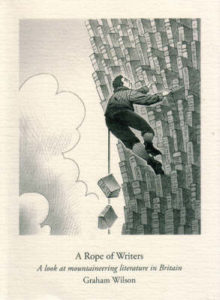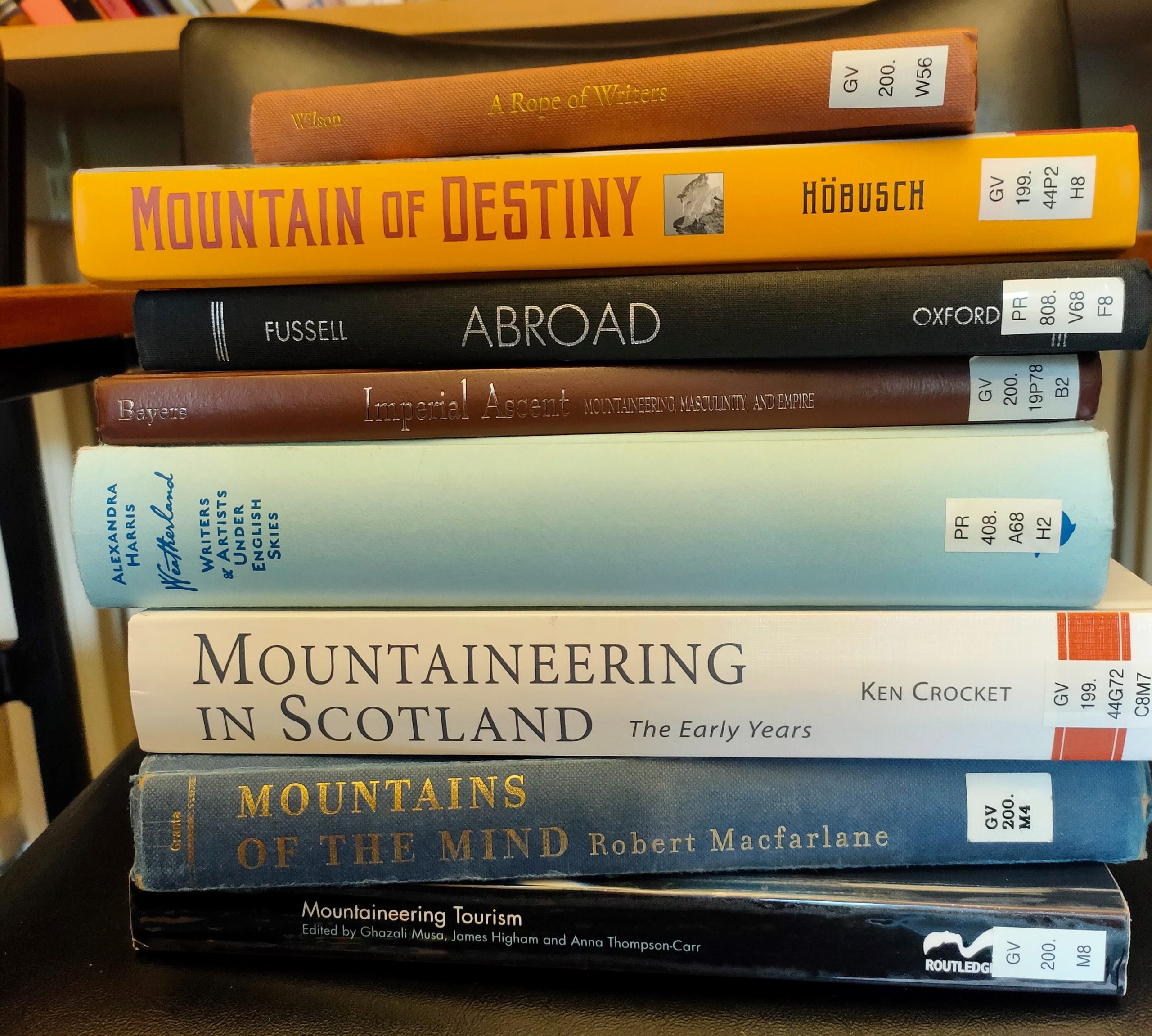When I went on maternity leave in 2021 pandemic restrictions were still in moderate swing, so when I went into the University Library a few weeks ago it was the first time in quite a while that I’d gone to the shelves to pick up a physical book with my own two hands. The pandemic combined with the ready availability of e-books had led me to forget the happy side-effect of going to fetch a real book: right beside it you find half a dozen equally interesting titles which you never knew existed. This was how I came out of the library with a much larger pile than I had planned, including a neat little volume titled A Rope of Writers.
This book, written by Graham Wilson, offers not so much a bibliography as a condensed biography of British mountaineering literature. As Wilson himself acknowledges in his introduction, a bibliography already exists in the form of Jill Neate’s Mountaineering and its Literature, first published in 1978 and updated in 1986. I have long since thought it a matter of some interest (and amusement) that mountaineering should require and easily fill a book-length bibliography. I doubt there are many other sports that could make the same claim, and the fact that mountaineering is so justly termed ‘the most literary of all sports’ offers both opportunities but also challenges to the historian studying it.
 Wilson’s comments about the development of mountaineering club journals, in particular, helped crystallise some of my thoughts about mountaineering, its literature, and the way that literature wrote a prehistory for mountaineering which (with a few honourable exceptions) identified modern climbers as the first to truly appreciate mountains. Wilson wonders whether, without the ‘support’ of publications such as the Alpine Journal (founded in 1863 to record the ascents of members of the British Alpine Club, and still going strong today), ‘climbing as a formalised sport would have existed’. He elaborates that
Wilson’s comments about the development of mountaineering club journals, in particular, helped crystallise some of my thoughts about mountaineering, its literature, and the way that literature wrote a prehistory for mountaineering which (with a few honourable exceptions) identified modern climbers as the first to truly appreciate mountains. Wilson wonders whether, without the ‘support’ of publications such as the Alpine Journal (founded in 1863 to record the ascents of members of the British Alpine Club, and still going strong today), ‘climbing as a formalised sport would have existed’. He elaborates that
A man, if he so wishes, can stand at the bottom of the cliff and, without reference to any outside source, climb to its top by any means he chooses and that is that. But once he returns to the valley and writes up his experience for others to read, then matters change. He is now suggesting a framework which the said others can either adopt or challenge…
More than just inspiring others to climb, though, reports in journals set standards about what was ‘sporting’, safe, or sensible on the rocks and mountains. Thus, as Wilson puts it, ‘the simple wanderings of a shepherd were transformed into a sport which, as all sports do, laid down… where to do it, how to do it, and most importantly, how to behave while doing it’.
I think this is a wonderfully apt summation of the importance of the role of journals. They didn’t just record the sport: they helped write it into being. Journals were equally significant, I believe, in the development of the history of mountaineering, and in particular of the idea that before mountaineering, most Europeans would rather avoid even looking at a mountain than dare to climb it. As I lay out in my ISLE article, ‘Mountain Gloom and Mountain Glory: The Genealogy of an Idea’, the very first mountaineering journal, the Alpine Journal, had a particularly prominent role to play.
What do I mean by this? Wilson observes that in addition to reports of ascents, any volume of a given journal ‘may contain other items to amuse or entertain’. Early volumes of the Alpine Journal are filled with articles which touch, in appropriately educational and edifying fashion, on various aspects of Alpine and mountain history. One such example, ‘The Growth of Mountaineering’, by C.E. Mathews, opens with the fascinating comment that club climbers were ‘making Alpine history with extraordinary rapidity’. For all that, ‘the prehistoric epoch was not so long ago’, and even as late as 1855 ‘the men who practised climbing for its own sake were so few that they might be counted on the fingers of one hand’. An earlier article, a review of a book The Abode of Snow: A Journey from Tibet to the Khyber Pass on Horseback, takes issue with the suggestion that a horseback journey could ever be identified as ‘mountaineering’. The anonymous reviewer comments, possessively, that the ‘introducers’ of the sport ‘have perhaps the best right to define its meaning’, observing that ‘The modern passion for foot-climbing as an athletic sport was felt to be so distinct that a new word “mountaineering,” had to be invented for it.’
There are so many telling points tied up in just these two examples. The sense of possession that mountaineers – who were also the writers of their club journals – felt over their sport and over its history. The idea that mountaineering as they practised it was something new, something exceptional, that set them apart from earlier history. ‘Climbing for its own sake’, as Mathews put it, distinguished what the men of the Alpine Club did from earlier feats performed from any more prosaic motivation. (Another writer to the Alpine Journal, C.T. Dent, comments with rather more ironic self-awareness, that ‘We have found it, long since, necessary to look upon ascents made by chamois hunters as counting for nothing’). And the underlying implication is that modern mountaineers did new and different things on mountains because they felt new and different things about them.
Mountaineering journals served, then, not just to create the sport itself, but also to write its history – or even, one might say, to establish its foundational myths. These myths asserted the exceptional nature of the modern mountaineers, placed them ‘first’ in loving mountains. In so doing, they relied on the construction of a prehistory during which people didn’t love mountains. As I elaborate elsewhere in my blog posts and other writings, this prehistory doesn’t ring true when you turn to sources from the early modern period (and long before). And why should it? It was part of the writing of a sport, and today we should read it for what it tells us of the creation of modern mountaineering, not of the premodern past.
Quotations from Graham Wilson, A Rope of Writers: A look at mountaineering literature in Britain (Millrace, 2006), pp. 30-32; C.E. Mathews, ‘The Growth of Mountaineering’, Alpine Journal vol. X (1880-82), p. 252; review of The Abode of Snow by Andrew Wilson, Alpine Journal vol. VII (1874-1876), p. 338; C.T. Dent, ‘Mountaineering in the Old Style’, Alpine Journal vol. XI (1882-1884), p. 393.

